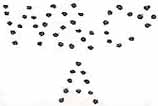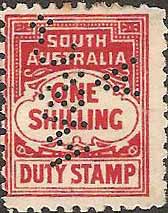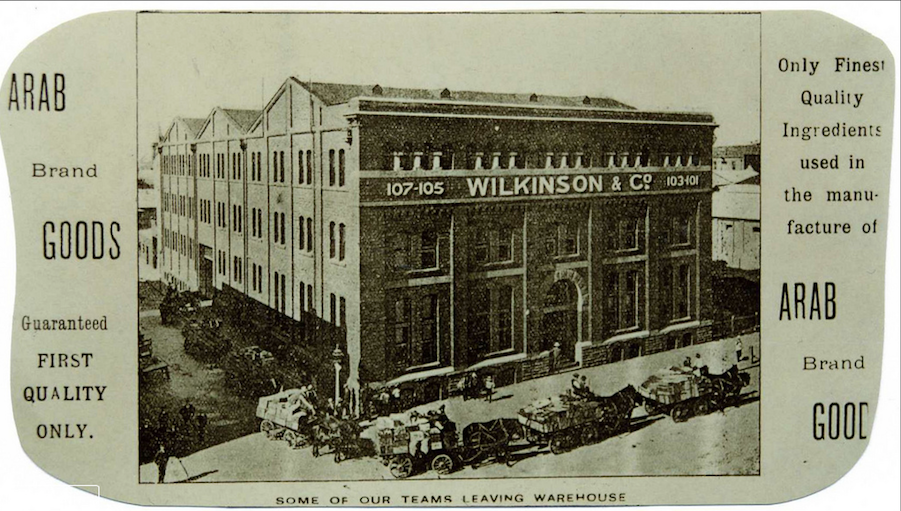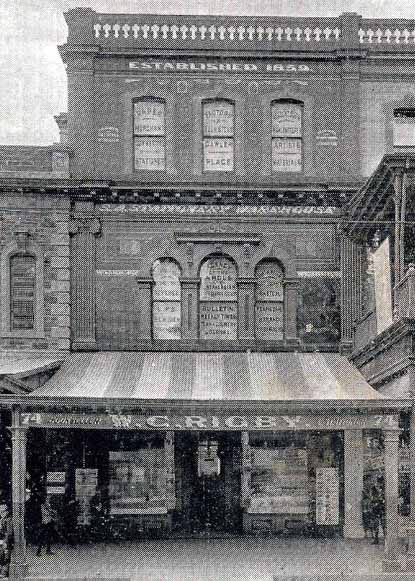|
Private Revenue Perfins of South Australia An Elsmore Coath production The authors would welcome your comments additions or input into this work W -------------------------------------------------------- W&Co/A.a
User: Wilkinson & Co Ltd Wholesale and Manufacturing Grocers Address: 101-107 Grenfell St, Adelaide, SA. Revenue Use: 1920 Series 2d, 1/-. Rarity Scale: 1920 Series 2d R4, 1/- R4. Background: *Wilkinson & Company was founded by Alfred Wilkinson in 1882 with the opening of a small grocery store in Marlborough Chambers. In 1884 Wilkinson acquired the wholesale grocery business of William Morgan and Co, of Currie Street. The business continued to grow and moved to bigger premises in Freeman Street. In 1898 a still larger purpose built warehouse was built in Grenfell Street, and this was extended by 45,000 square feet in 1909.
Wilkinson & Co became major importers, packers and wholesalers of perishable goods, mainly tea, but also including, coffee, self-raising flour and general groceries. Among the registered trademarks were the “Arab” range of products as well as “Viceroy”, “Mandarin”, “Economic”, “Bulldog”, “Pansy”, “Warrior”, “Durbar”, “Gold Medal” and “Welfare” brand of teas. Company branches included Broken Hill,(NSW), and Port Adelaide, with resident representatives in other parts of South Australia. In July 1911, the company went into voluntary liquidation, and then re-formed as a Limited Liability company.
Around 1948, Wilkinson & Co, Ltd, purchased the entire chain of S.O. Beilby Grocery stores in South Australia and by 1956 they had built this up to 28 Stores.
In 1951 the company had sold its Grenfell Street premises to the Post Master General and the building became a mail exchange.
The company continued to trade until March 1955 and the S.O. Beilby Grocery stores continued to operate but these diminished over time and by 1966 there were only 6 stores still operating.
Device: The W&Co/A.a device was most likely a single die device as it is known to produce single central strikes in a variety of formats of postage stamps. The device came into service in about 1901 and at this time it had quite fine pins. Early use until about 1914 shows reasonably clear strikes with only a few pins missing or blocked, however later use in the period 1915 – 1919 shows the device falling into disrepair and this is evidenced by an increased incidence of incomplete strikes. No usage of this early pattern with finer pins has been reported on revenue or railway stamps. In about 1920 the device appears to have been repaired and a new set of thicker pins were fitted. This pattern with its thicker pins is the pattern that is found on the revenue stamps of South Australia. The device continued to be used until 1947 and this late usage is reported on both revenue stamps of South Australia and the postage stamps of Australia. Related patterns: Nil * David Tuckwell – Flickr *TROVE
-------------------------------------------------------- W.C./R.a
User: Rigbys Limited Booksellers and Publishers Address: 53 Hindley Street, Adelaide, SA 74 King William Street, Adelaide, SA Revenue Use: 1902 Series 1d. Rarity Scale: 1920 Series 1d R1. Railway Use: 1885 issue: ½d, 1d, 3d, 6d. Roulette: ½d, 1d, 3d. Rarity Scale: 1885 Issue ½d R3, 1d R2, 3d R2, 6d R4. Roulette ½d R4, 1d R4, 3d R4. Background: *William Charles Rigby was born in London in 1834 and during his youth he worked in a London booksellers shop. In 1853 he purchased a 48-ton lugger, ‘The Gem’, and sailed to Australia with his family and a crew of seven men. He came to Adelaide in 1859 and opened a bookshop at 53 Hindley Street, with five cases of stock valued at £229.16.7d. The city and colony were only twenty three years old and the settlers avidly sought out books to read, and W. C. Rigby began to establish a reputation as a supplier of fine books. By 1875 with the business growing Rigby bought larger premises at 74 King William St and commenced trading from there in 1876. (Ed: Conflicting reports say by 1877 Rigby built 74 King St) and this cemented Rigby as one of Adelaide's leading booksellers and he maintained this position in the trade until he retired on his 75th birthday in 1909. William died in 1913. On William’s retirement, John Morley Bath took over the running of the business which remained stable until the early 1920's when it expanded into King William Street and included a modern library, chemist and soda fountain; in fact Rigbys became quite famous for their milk shakes. In the mid 1920's Rigbys retail outlet was sold and it was not reestablished until the company purchased the Coles Book Arcade in the early 1930's. In 1945 J. Morley Bath died and V. M. Branson took over as Managing Director, and he continued in this role until 1973. Rigby’s expanded into educational publishing in 1947 and then moved into general publishing, with books by and for Australians. The 1950's saw branches opened in Melbourne, Brisbane and Sydney and by 1956 all of Rigbys Adelaide operations were consolidated under the one roof at premises in James Place, which was the most modern school bookshop and wholesale warehouse in Australia. Rigby’s celebrated their centenary in 1959 with an outstanding year, with full page coverage in the papers. Their list of publications, especially textbooks increased rapidly during this time. A Perth Branch opened in 1962. In 1973 the ownership of the company changed hands and V.M. Branson left the company. At this time staff numbers had expanded from 44 people in 1947 to over 200 in 1973. Rigbys had become the largest Australian owned book publisher by 1977, commanding some 6.5% of the retail market and representing 35% of the sales of Australian owned publishing. Staff numbers totaled over 250 people, half of whom were based in Adelaide and the other half in the four mainland cities. In 1977, Octopus Books, who had commenced a franchise with Rigby’s in 1973 and the MacMillan Company, chaired by Mr. Paul Hamlyn were both interested in taking over Rigbys, but these offers did not eventuate. On the 30th June 1978 the Octopus franchise was terminated. By 1979 Rigbys was Australia's largest publisher and was producing up to 400 new titles each year. In 1979 the Sydney based, Reed Consolidated Industries Limited acquired Rigbys and the company became known as Rigbys Limited and became part of the Rigbys Group of Companies, which included Lansdowne Press, Hanna-Barbera and Summit Records.
74 King William St Device: The W.C./R.a device is a multi die device with at least 2 dies in a horizontal array. The dies are essentially identical so we have listed it as a single pattern.
The W.C./R.a pattern is most commonly found on the postage stamps of South Australia in the period 1896-1906, and it is also found on the railway parcel stamps of South Australia.
However the pattern is also found on the Tramway parcel stamps issued by the Silverton Tramway Company (see NSW Section).
The Silverton Tramway line ran within NSW so this W.C./R.a device used on Silverton Tramway parcel stamps of NSW means that it is covered in both our NSW and SA listings.
The spacing of the 2 (or more) dies was set to suit the small format postage stamps of South Australia when struck in position 1. Accordingly when the device is used on wider format stamps such as the Long Tom issues of South Australia or the railway stamps of South Australia or NSW it often appears as a partial or a pair of partial strikes.
Related patterns: Refer to other Rigbys Limited patterns in:
NSW: W.C./R.a
*SA State Library -------------------------------------------------------- © copyright 2011 |





